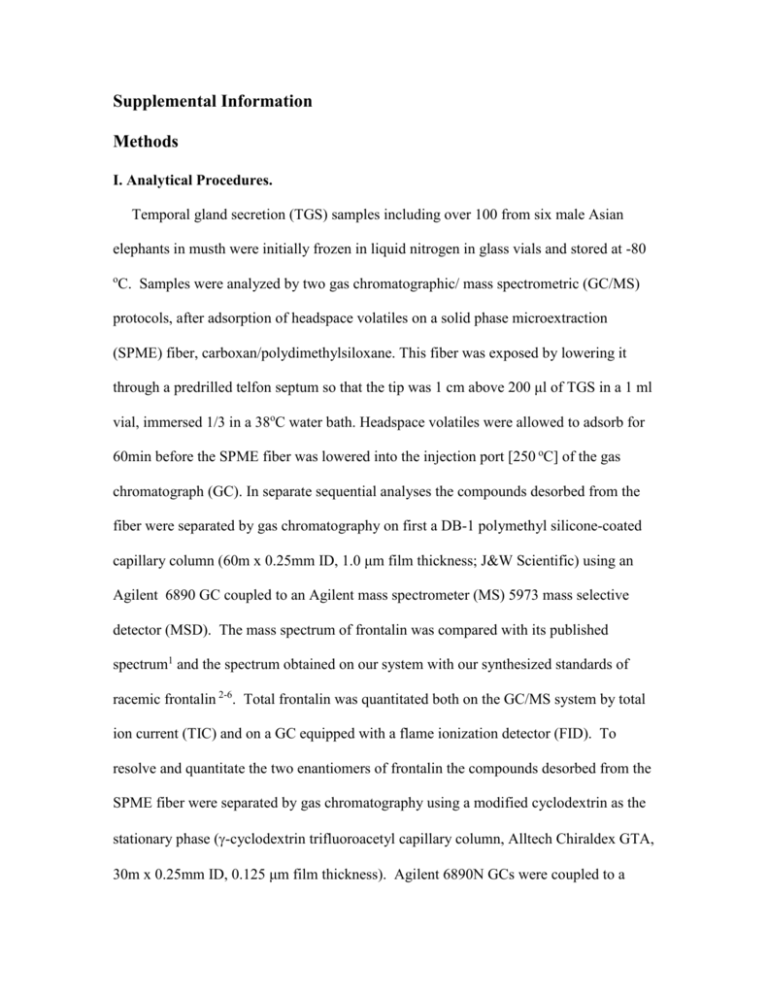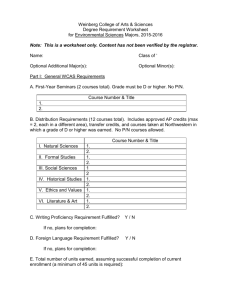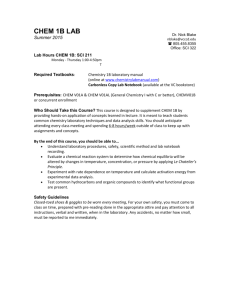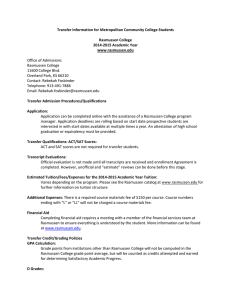Supplementary information - Word file (29 KB )
advertisement

Supplemental Information Methods I. Analytical Procedures. Temporal gland secretion (TGS) samples including over 100 from six male Asian elephants in musth were initially frozen in liquid nitrogen in glass vials and stored at -80 o C. Samples were analyzed by two gas chromatographic/ mass spectrometric (GC/MS) protocols, after adsorption of headspace volatiles on a solid phase microextraction (SPME) fiber, carboxan/polydimethylsiloxane. This fiber was exposed by lowering it through a predrilled telfon septum so that the tip was 1 cm above 200 μl of TGS in a 1 ml vial, immersed 1/3 in a 38oC water bath. Headspace volatiles were allowed to adsorb for 60min before the SPME fiber was lowered into the injection port [250 oC] of the gas chromatograph (GC). In separate sequential analyses the compounds desorbed from the fiber were separated by gas chromatography on first a DB-1 polymethyl silicone-coated capillary column (60m x 0.25mm ID, 1.0 μm film thickness; J&W Scientific) using an Agilent 6890 GC coupled to an Agilent mass spectrometer (MS) 5973 mass selective detector (MSD). The mass spectrum of frontalin was compared with its published spectrum1 and the spectrum obtained on our system with our synthesized standards of racemic frontalin 2-6. Total frontalin was quantitated both on the GC/MS system by total ion current (TIC) and on a GC equipped with a flame ionization detector (FID). To resolve and quantitate the two enantiomers of frontalin the compounds desorbed from the SPME fiber were separated by gas chromatography using a modified cyclodextrin as the stationary phase (-cyclodextrin trifluoroacetyl capillary column, Alltech Chiraldex GTA, 30m x 0.25mm ID, 0.125 μm film thickness). Agilent 6890N GCs were coupled to a Waters Micromass GCT mass spectrometer for New Zealand analyses and to an Agilent MS 5973 MSD for USA analyses. Standards of our synthesized enriched (+) [1R,5S] and enriched (–) [1S,5R] enantiomers 2-6 exhibiting 21% and 30% enantiomeric enrichment respectively and 1H NMR, 13C NMR and MS spectra consistent with the literature 6, as well as the synthesized racemic mixture were used to detect the retention time of frontalin and were calibrated against internal standards of authentic synthetic compounds of measured concentration. TIC values as well as the area values of m/z 142 and m/z 100 were measured to ensure accurate quantitation of frontalin as co-eluting peaks were detected occasionally. The USA chiral system allowed an optional split mode so that quantitation and identification could be confirmed, employing FID simultaneously with MS. II. Bioassay Procedures. Based on the discovery of the presence and natural release of the two enantiomers of frontalin and using the analyses of many banked TGS samples whose enantiomeric ratios of frontalin had been established, we re-examined our data from previous assays of two categories of males and three categories of females7, and performed new sets of assays with three categories of mid-musth TGS (young teenage males in short “moda” musth, older teenage males and males older than 25 years). These additional representative paired bioassays using aliquots of previously analyzed TGS samples bioassays were conducted using methods described in detail previously 7, 8. Five categories of elephant conspecifics were tested: older males (21-43y), young males (13-20y), pregnant females, females in the follicular stage of oestrus and females in the luteal phase. Chemosensory responses monitored included sniffs, checks, places and flehmens; avoidance behaviours scored included sample circling, ears erect, backing up, audible forceful exhalation, foot scuffling, running away and accompanying vocalizations of trumpeting and roaring. For precise definitions and expanded list see previous publications7-12. Parametric and nonparametric statistics used included T-tests (Figure 1d) and one way analysis of variance (ANOVA) on ranks (Figure 1a, b, and c), followed by all pairwise multiple comparison procedures (Dunn’s Method)13. In Figure 1a, the statistically significant differences (SSD) were between all groups, P < 0.05, Difference of Ranks (DR) = (20.89–61.57), Q = (2.53–7.35). For Figure 1b similar statistical procedures were employed; SSD, P < 0.05, were between 13–20y and 21–30y groups, and between 13– 20y and 31–43y groups respectively, DR = 15.51 and 18.94, Q = 2.59 and 2.49. For Figure 1c similar statistical procedure as in Fig. 1a and 1b revealed SSD, P < 0.05, between 6 groups as indicated by paired sequential numbers. [1-1] DR = 36.40, Q = 4.24; [2-2] DR = 26.34, Q = 2.81; [3-3] DR = 43.52, Q = 3.96; [4-4] DR = 25.76, Q = 2.73; [55] DR = 29.32, Q = 3.16; [6-6] DR = 28.66, Q = 3.09. T-tests were employed for data in Figure 1d. SSD, P = 0.001, were demonstrated between the following groups as indicated by paired sequential numbers. The comparisons were between similar conspecific groupings or within TGS-type assays. [1-1] Degrees of freedom (DF) =4, t = 4.66 [P = 0.01]; [2-2] DF = 4, t = 4.86; [3-3] DF = 4, t =8.61; [4-4] DF = 4, t = 8.9. References for Supplemental Information 1. Gore, W. E., Pearce, G. T., & Silverstein, R. M. Mass spectrometric studies of the dioxabicyclo [3.2.1] octanes: multistriatin, frontalin and brevicomin. J. Org. Chem. 41, 607 (1976). 2. Mori, K. Synthesis of optically active forms of frontalin. Tetrahedron 31, 1381-1384 (1975). 3. Bartlett, P. A. et al. Synthesis of frontalin, the aggregation pheromone of the Southern pine beetle. J. Chem. Educ. 61, 816-817 (1984). 4. Sharpless, K.B. et al., The osmium-catalyzed asymmetric dihydroxylation: a new ligand class and a process improvement. J. Org. Chem. 57, 2768-2771 (1992). 5. Turpin, J. A. & Weigel, L. O. Enantioselective synthesis of the 6,8-dioxabicyclo[3.2.1]octane skeleton by asymmetric dihydroxylation. Tetrahedron Lett. 33, 65636564 (1992). 6. Satiago, B. & Soderquist, J. A. Nonracemic frontalin via copper and palladium-based sketetal construction and the asymmetric dihydroxylation. J. Org. Chem. 57, 58445847 (1992). 7. Rasmussen, L.E. L. & Greenwood, D. R. Frontalin: a chemical message of musth in Asian elephants. Chem. Senses 28, 433-446 (2003). 8. Rasmussen, L.E.L. ) Source and cyclic release pattern of (Z)-7-dodecenyl acetate, the preovulatory pheromone of the female Asian elephant. Chem. Senses 26, 611-24 (2001). 9. Rasmussen, L. E. L., Lee, T. D., Zhang, A., Roelofs, W. L., & G. D. Daves, Jr. Purification, identification, concentration & bioactivity of (Z)-7-dodecen-1-yl acetate: Sex pheromone of the female Asian elephant, Elephas maximus. Chemical Senses 22, 417-438 (1997). 10. Schulte B. A. & Rasmussen, L. E. L. Signal-receiver interplay in the communication of male condition by Asian elephants. Anim. Behav. 57, 1265-1274 (1999). 11. Rasmussen, L. E. L., Lazar, J., & Greenwood, D. R. The olfactory adventures of elephantine pheromones. Biochem. Soc. Trans. 31,137-141 (2003). 12. Lazar, J., Rasmussen, L. E. L., Greenwood, D. R., Bang, I.-S. & Prestwich, G. D. Elephant albumin: a multi-purpose pheromone shuttle. Chemistry & Biology 11, 1093-1100 (2004). 13. Sokal, R. R. & Rohlf, F. J. Biometry (Freeman & Co., New York, 1995).








